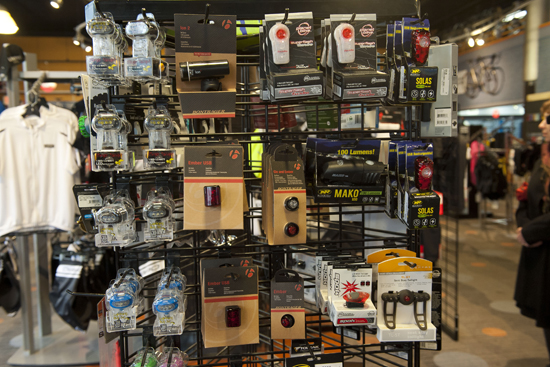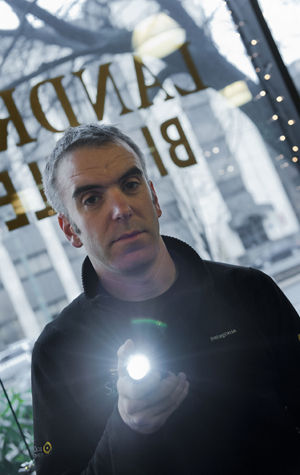Bike-Safety Gear: See, Be Seen, and Heard
Alum designs car horn for bicycles

Biking 17 miles round-trip every day from Medford to his job in Woburn, Jonathan Lansey has his share of close calls. Particularly on long stretches of suburban highway, drivers often seem oblivious to his presence. As a research engineer who’s paid to solve problems, Lansey (GRS’10) decided to tackle this one, and came up with Loud Bicycle, a car horn for cyclists. Now in the midst of a Kickstarter campaign to get the horns manufactured, Lansey has been road-testing the prototype and has found that the sound often stops cars in their tracks.
In the wake of five bicycle fatalities in Boston this year, including the recent deaths of two Boston University student cyclists in incidents on or near Commonwealth Avenue, concerns about safety are urgent. Between January 1 and November 13, 2012, Boston Emergency Medical Services responded to 579 bicycle-related incidents. It’s dangerous out there, but as habitual bikers like Lansey know, even the most vigilant and cautious bikers can benefit from gear that makes them easier to be seen and heard, by both drivers and pedestrians.
“I get cut off by drivers, and people pull right into me,” says Lansey, who is conservative about horn use, but ends up blasting it at least once during a commute. “I was surprised at how effective it is. Cars react without even looking. They immediately respond by braking.” He adds that he can see confusion and “maybe a little guilt” on the faces of drivers who might not have seen him and who certainly didn’t expect the horn sound to come from a bike.

As an alternative to existing, often-feeble bike horns and even feebler bells, Loud Bicycle could save lives, Lansey hopes. It already may have saved him from a collision, at the very least. “One time I was biking along and focusing on the car to my right, which had its blinker on, and I didn’t see this guy who was making a left turn from the right lane, to cut across me,” he says. “This was at night. I honked, and he braked. I was really shaken up; it’s likely that I would’ve been hit.”
Lansey says drivers react to car horns before they even know where the sound is coming from. A motorist who gets beeped at while backing out of a driveway, for example, will immediately brake. He is counting on these kinds of reflexive reactions to keep cyclists safe.
“I like the idea of having the choice of a bell (for a friendly reminder/passing pedestrians) and a real horn, for when a car is neglecting traffic laws and is about to hit me,” a BU student commented on Lansey’s Kickstarter site. “A bell there just doesn’t seem to cut it.”

As he navigates through more populated areas, Lansey also never underestimates the power of yelling. As for other horns, he’s a fan of AirZound, a compressed air horn, with several models, selling for $30 to $36. The device has a volume control switch, and because it uses an air canister, requires no batteries. The canister can be refilled with a bicycle pump. The 115-decibel AirZound was developed in the United Kingdom by a 30-mile-a-day bike commuter (dump “that pathetic bell now,” its website urges). “The downside,” says Lansey, is that although it has around the same decibel level, “it doesn’t sound quite like a car. It sounds like a really high-pitched whistle, and you can only honk it for about two seconds.” Loud Bicycle can sustain a 30-second honk, although Lansey says he can’t imagine honking the horn for that long.
At Landry’s Bicycles on Comm Ave, the selection of bike horns runs from vintage-looking bells ranging from $9 to $12 to a shiny handlebar-mounted bugle that parents buy for $19 for their young kids. “Bells are good; you get out of Fenway Park and work your way through the crowds with that ring-ding-ding,” says Landry’s manager Mark Vautour. But he adds that mostly, under those conditions, “I just yell at people.”
For lights, the other crucial safety gear, bikers have many more options. Bike lights can cost up to $700. “We have lights that would cook a chicken,” says Vautour, who has worked at Landry’s for 16 years. “When you’re shopping for a bike light, you have to ask yourself, do you want to see or be seen? Around BU the streets are well lit, so in the city you want to be seen.”

Vautour is adamant that city bikers not venture out after dark without front and rear lights, at the very least. (Bikers not concerned about the extra weight can attach colored lights to their wheel spokes, and clip-on lights are great for outerwear and backpacks.) “You need working lights,” he says, noting that if a driver’s car lights don’t work, they will be pulled over by police. Lights should be considered essential for bikes, too. Landry’s carries front-mounted lights, which cost $350 and $500 and can light up trails for backcountry mountain bikers. For city biking, his favorite is the rechargeable Lumina 500 Night Rider, which costs $110. Basic rear lights begin at $13, and for around $40 you can buy a battery-powered front and rear light set. Vautour neither recommends nor sells lights charged by minigenerators powered by the cyclist himself. “Generator lights are never bright enough,” he says. And even though it’s not a huge problem in Boston, lights are sometimes stolen. “When you park the bike, take the light with you,” he says. “That’s just part of reality.”
For an additional investment of $18, cyclists can increase their visibility with safety light straps that can be used on arms or legs. A big seller at Landry’s, the straps, made by Planet Bike, run on an LED battery and are visible up to 2,000 feet.
Also kicking around on the internet is a trend of painting entire bikes so they glow in the dark. Vautour hasn’t seen much evidence of this locally. But on an instructables.com tutorial involving phosphorescent paint, the creator says, “I feel much safer riding in the dark. Cars are able to spot me from quite a far distance…Safety and style…it’s a win-win.”
Comments & Discussion
Boston University moderates comments to facilitate an informed, substantive, civil conversation. Abusive, profane, self-promotional, misleading, incoherent or off-topic comments will be rejected. Moderators are staffed during regular business hours (EST) and can only accept comments written in English. Statistics or facts must include a citation or a link to the citation.